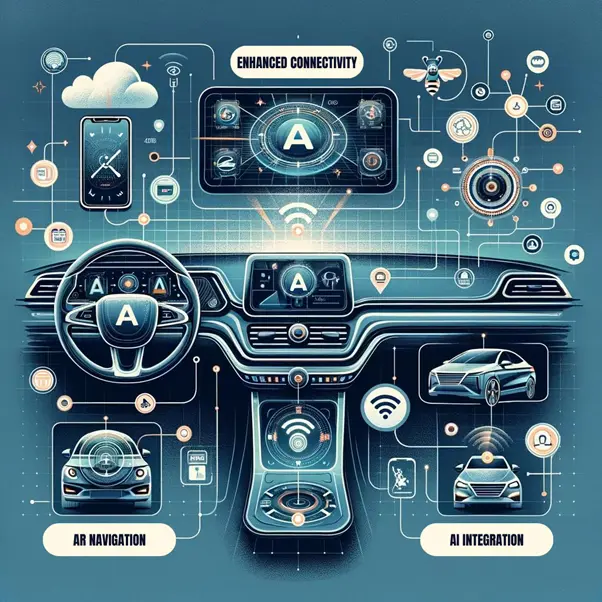
Introduction:
The modern car infotainment system is a crucial part of our daily driving experience, by blending information and entertainment features it enriches our time on the road. This article explores the evolution of infotainment systems, their importance in shaping brand perception, and key trends reshaping the automotive industry.
Defining the Infotainment System:
A car infotainment system generally refers to a multimedia interface that combines functionality such as navigation, audio, video, and the internet among other functions into a versatile platform. It integrates information, entertainment, and control all in one place inside a vehicle hence providing driver and passenger with an extremely convenient and pleasurable driving experience.
The First Infotainment System:
The design of an infotainment system was started in the late 1980s when General Motors unveiled a new system dubbed the “Delco-GM/Bose Symphony Sound System” on their Cadillacs. It combined high-quality audio with digital controls, setting the stage for sophisticated entertainment systems in cars.
All the latest infotainment systems only changed the name as the primary content – the in-dash cassette player of yesteryears was more in-car entertainment than anything else.
It was in 2001 that the first major disruption befell over mere radio, cassette, USB and CD slots. iDrive, BMW’s system changed the relationship between modern technology and motorcar owners in the mass market. It consisted of three elements: an easy-to-use central controller, logically arranged menus, and a computer-controlled interface between the driver and the powertrain system. The other manufacturers followed suit.
The beginning of the twenty-first century was marked by the official registration of the definition “infotainment,” which dealt with multifunctional systems.
The Evolution of Modern Infotainment Systems:

Modern infotainment systems are undergoing changes similar to how telephones evolved over time. What started as simple audio systems today has transformed into complex interfaces featuring touch-screen displays, voice commands, smartphone integration, and advanced drive-assist systems. The advent of such systems has practically turned them into an essential touch-point for any user, impacting the brand perception and eventually the purpose of getting behind the wheel.
Importance of Infotainment Systems Today:
A good quality infotainment system will add to the car brand’s image while a bad one may break it. Quick and seamless is what the user expects, and an ineptly designed infotainment system can mar a manufacturer’s reputation. These days, makers of cars focus primarily on engineering a user-friendly, good-looking, feature-rich infotainment experience.
Key Trends in the Infotainment Space:
Key trends are established based on data collected from various sources. These may include industry reports together with market analysis among others. Some of the trends include:

1. Enhanced Connectivity: Infotainment systems are increasingly integrating with smartphones and cloud services.
2. Augmented Reality (AR) Navigation: Providing more intuitive and immersive navigation experiences.
3. AI Integration: Leveraging artificial intelligence for video, voice, personalization and generative AI
4. Over-the-Air (OTA) Updates: Enabling remote software updates to keep systems up-to-date.
Evolution of the Automotive Infotainment ‘Value Creation’ Chain Landscape
With the developments that have occurred these days, cars are not just about the driving experience; they must cater to an enhanced in-cabin user experience as well. This has consequently transferred value creation, from the Tier-1 suppliers to the OEMs that now lead the creation of infotainment system concepts, connectivity systems, as well as the security features prevalent in the cars. The OEMs increasingly use the features of the infotainment system to create differentiation while leveraging deep functional competence and reference architectures of the Tier-1 infotainment vendors. Similar to the iDrive from 2000s, The Mercedes Benz OS, Mahindra’s Adrenox are leading examples of symbiotic disruptions today where passenger car OEMs are orchestrating the Infotainment user experience.
The automotive industry has seen a shift in hardware-software value stream too – with generic and high-volume hardware, a middleware, and an application layer. Companies such as Qualcomm, NXP, and others are emerging as leaders in creating robust hardware platforms. Middleware, represented by QNX and Blackberry IVY, abstracts hardware complexities, allowing OEMs and Start up automotive software companies to build customer applications directly on the Infotainment platforms without having to navigate the barriers of entry. This shift has led to not just an increase in OEMs’ software engineering capabilities, but has also led to a new breed of Automotive Software companies that are creating innovative and disruptive software solutions for these infotainment systems in this newly democratic infotainment landscape.
Thus, not just are cars getting smarter with more features, they are now available at competitive price points with features moving quickly from global premium vehicle models into the mass markets.
A recent study by J.D. Power revealed that a modern car launched in 2022 has on an average, a whopping 22 features.
Conclusion:
The evolution of the modern car infotainment system has transformed the automotive industry. With a focus on user experience, connectivity, and advanced technology, cars have become safer, feature-rich, and more enjoyable to use. With advent of an inclusive technology landscape, there are more players, and more features created every day. As we move forward, customers can look forward to even more exciting innovations in the world of automotive infotainment.






